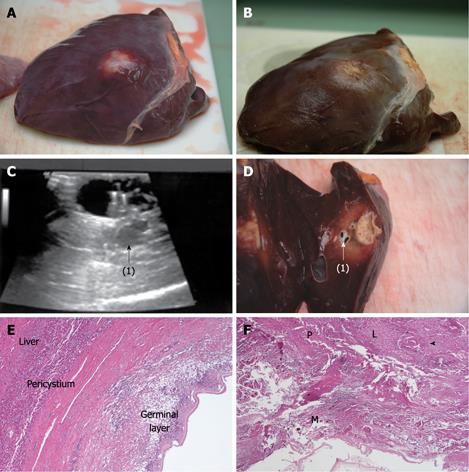Copyright
©2009 The WJG Press and Baishideng.
World J Gastroenterol. Jul 14, 2009; 15(26): 3232-3239
Published online Jul 14, 2009. doi: 10.3748/wjg.15.3232
Published online Jul 14, 2009. doi: 10.3748/wjg.15.3232
Figure 3 Hydatid cyst of the liver treated with RTA.
The upper panel shows the surface of the liver before (A) and after (B) RTA. The procedure caused cyst retraction. The middle panel shows pre-procedure ultrasound (C) and post-RTA section (D) of the cyst. A transverse US scan shows the RITA needle expanded inside the cyst and a smaller adjacent cyst (1) situated within the necrotic area surrounding the treated cyst. Histology showed the smaller cyst was necrotic and killed despite no direct treatment. In the lower panel, histology (HE stain, × 4) of an untreated cyst (E) is compared with that of the treated one (F). In the former, all structures are well recognizable, while in the latter the cyst layers are totally necrotic. M: Germinal membrane; P: Pericystium; L: Liver parenchyma. Arrow tips indicate necrotic portal tracts. 1: Adjacent cyst.
-
Citation: Lamonaca V, Virga A, Minervini MI, Di Stefano R, Provenzani A, Tagliareni P, Fleres G, Luca A, Vizzini G, Palazzo U, Gridelli B. Cystic echinococcosis of the liver and lung treated by radiofrequency thermal ablation: An
ex-vivo pilot experimental study in animal models. World J Gastroenterol 2009; 15(26): 3232-3239 - URL: https://www.wjgnet.com/1007-9327/full/v15/i26/3232.htm
- DOI: https://dx.doi.org/10.3748/wjg.15.3232









